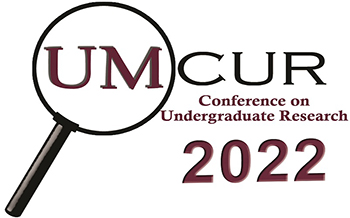Project Type
Presentation
Faculty Mentor’s Full Name
Erim Gomez
Faculty Mentor’s Department
Wildlife Biology
Abstract / Artist's Statement
Amphibian populations around the world are declining at an alarming rate and the decline of western Montana amphibians reflects this trend. As part of the restoration monitoring efforts at Milltown State Park, MT, native amphibian occupancy should be measured. I chose Milltown State Park because it is the largest Superfund site in the U.S. and millions of dollars have been spent on restoration efforts since 2008. However, little is known about amphibian occupancy at the site. Currently, egg masses of the native Columbia spotted frog are found in permanent wetland sites at Milltown State Park, yet larvae detection at these sites was extremely low in the summer of 2021. I am proposing to determine whether predation by nonnative fish is the primary driver of the low larval recruitment. Specifically, I will count egg masses of Columbia spotted frogs (Rana luteiventris) in April to establish a baseline of breeding events at seasonal (fish-less) and permanent (fish-present) wetlands at Milltown State Park. Once eggs have had time to develop and hatch into larvae, I will conduct repeated catch-and-release sampling of larvae at both seasonal and permanent wetlands at the park. If I find fewer larvae in the permanent wetlands than in the seasonal wetlands, I will conclude that fish predation may be the primary driver of the differences in amphibian larvae detectability and recruitment. This mechanism would need to be tested in future studies, ideally in the lab and with field observations. If I do not find a significant difference in larval abundance between the seasonal and permanent wetlands, I will conclude that factors other than fish presence are limiting the recruitment of larvae (e.g. heavy metals, infectious disease, invertebrate predation, etc.). This research is important for assessing the success of the restoration project at Milltown State Park, with implications for further work that may be needed to improve native amphibian habitat. It has broader significance for the protection of native amphibian species in Montana.
Category
Life Sciences
Low Amphibian Larvae Recruitment at Restoration Site in Western Montana: Is Fish Predation Responsible?
UC 331
Amphibian populations around the world are declining at an alarming rate and the decline of western Montana amphibians reflects this trend. As part of the restoration monitoring efforts at Milltown State Park, MT, native amphibian occupancy should be measured. I chose Milltown State Park because it is the largest Superfund site in the U.S. and millions of dollars have been spent on restoration efforts since 2008. However, little is known about amphibian occupancy at the site. Currently, egg masses of the native Columbia spotted frog are found in permanent wetland sites at Milltown State Park, yet larvae detection at these sites was extremely low in the summer of 2021. I am proposing to determine whether predation by nonnative fish is the primary driver of the low larval recruitment. Specifically, I will count egg masses of Columbia spotted frogs (Rana luteiventris) in April to establish a baseline of breeding events at seasonal (fish-less) and permanent (fish-present) wetlands at Milltown State Park. Once eggs have had time to develop and hatch into larvae, I will conduct repeated catch-and-release sampling of larvae at both seasonal and permanent wetlands at the park. If I find fewer larvae in the permanent wetlands than in the seasonal wetlands, I will conclude that fish predation may be the primary driver of the differences in amphibian larvae detectability and recruitment. This mechanism would need to be tested in future studies, ideally in the lab and with field observations. If I do not find a significant difference in larval abundance between the seasonal and permanent wetlands, I will conclude that factors other than fish presence are limiting the recruitment of larvae (e.g. heavy metals, infectious disease, invertebrate predation, etc.). This research is important for assessing the success of the restoration project at Milltown State Park, with implications for further work that may be needed to improve native amphibian habitat. It has broader significance for the protection of native amphibian species in Montana.
